
After Labour MP Stephen Kinnock wrote in support of a Norway-style Brexit, former minister and EU commissioner PETER MANDELSON responds on why it would be a disastrous outcome for Britain.
Why be a rule-maker when you can be a rule-taker, seems to be the mantra doing the rounds at the moment with some MPs warming to the prospect of a Norway style arrangement, either as a temporary step towards a more distant relationship with the EU or even as an end in itself. It has been suggested that this would somehow become an outcome which would satisfy everybody, regardless of the way in which they voted in 2016 and would provide a sensible solution to the Brexit saga. However, this assumption is unrealistic to say the least and whilst not only failing to end the Brexit debate in this country, would just lengthen it, providing a sub-optimal solution to a complex problem.
There are many reasons why the Norway option would not work or be a desirable outcome for this country, where what is meant by Norway is membership of the European Economic Area.
MORE: STEPHEN KINNOCK: Forget a second vote – Norway is the only way to avoid the cliff
Last week it was suggested in this paper by the Labour MP Stephen Kinnock that the Norway option ‘is the only way to avoid the cliff’. Whilst I do not question Stephen’s motives – and have long said that he has a strong future ahead of him in the Labour party – I think the ship has sailed on this issue. There are eleven points on which I would take issue with Stephen’s case and lead me to conclude that Norway is not a solution to the Brexit conundrum.
1.’It would deliver the narrow 52:48 Leave mandate by pulling us out of the EU’s political institutions, while retaining frictionless trade with the 500 million consumers on our doorstep.’ As a matter of fact, it would not lead to frictionless trade with the European Union. The EEA is not a customs union and customs checks do take place between EU and non-EU EEA members, as happens on the Norwegian-Swedish border.
2.’We regain control over immigration: articles 112 and 113 of the EEA agreement enable any EEA country to suspend and reform any one of the four freedoms that underpin the single market. Yes, the EU could take retaliatory measures, but the fact is that these articles would actually provide a solid treaty-based basis for negotiation, and moreover this would go with the grain, given that there is a growing appetite across the EU to review and reform the free movement of labour.’ This argument fails to acknowledge that the emergency brake has only ever once been used – by Liechtenstein, a country which due to its size cannot be compared with the United Kingdom. It is not designed to be used unless the member of the EEA doing so can prove, as per article 112, that it is experiencing ‘serious economic, societal or environmental difficulties’. Entering the EEA with the aim of wanting to use this emergency break would be entering in bad faith as the brake is meant for emergency situations only. Moreover, article 114 of the agreement allows other members to take retaliatory measures, meaning any triggering of such an emergency brake would leave us facing adverse consequences. The argument also fails to understand that the debate right now in the EU is not about free movement within the EU but immigration from outside the EU into the EU and, importantly, there are existing checks and controls on free movement into the UK which no UK government has chosen not to employ. There is no need to leave the EU to address free movement, it can be done from within.
3.’We would regain legal sovereignty as the EEA falls under the jurisdiction of the EFTA Court, which does not have direct effect over national law. This is in stark contrast to the arbitration system that is proposed under the prime minister’s deal, which enables full jurisdiction for the European Court of Justice via the back door. The idea that in EFTA we would be a vassal state of the EU if we were in the EEA is a nonsense.’ This is disingenuous. Whilst EFTA EEA members follow judgements by the EFTA court, when it comes to single market rulings, the EFTA court follows rulings by the European Court of Justice, in order to allow for a level playing field between EU and non-EU EEA members, meaning that despite being formally outside of the remit of the ECJ, in fact ECJ rulings would still apply.
4.’It would solve the Irish border issue, because by definition it is a UK-wide solution; a fact that has not gone unnoticed by the DUP.’ This is not correct. The EEA is not a customs union but an extension of the single market (with the exception of fisheries and agriculture) to three non-EU members. Inside the EEA, customs checks would still have to apply between the UK and every EU member state, including the Republic of Ireland and therefore, in itself, would not resolve the border issue.
5.’The EEA actually exists. It is a well-established and fully ratified set-up that would finally put us on the front foot, and the transition period would be used primarily… By leaving the EU and joining the EEA the UK would become the leading light in a new group of ‘outer ring’ countries that sit outside the political project while retaining the full market participation.’ Whilst it is true that the EEA already exists, the real issue is whether we could actually join the EEA at all. At the moment, the EEA is only open to EU members and the three (out of four) members of the European Free Trade Area which have chosen to participate. As such, if we were to leave the EU the only way to join the EEA would be through EFTA and this makes an assumption about whether the other four EFTA countries would allow us to join. We would be larger than all of those countries combined and if we were only looking at the EEA as some kind of half-way house then there would be little incentive for them to let us in.
6.’The transition period would be used primarily to tweak the EFTA Convention so that we can participate in a customs union with the EU.’ To tweak the EFTA convention to allow for what would amount to further British exceptionalism when the goodwill towards us has been exhausted. Allowing for some kind of EEA + EU-UK Customs Union is likely to be unacceptable to the existing EEA-EFTA members, where none of them is in the EU’s Customs Union. It would also raise huge problems for EFTA itself when negotiating free trade agreements internationally, if the UK, as one of its members, had its hands tied due to it being in a Customs Union with the EU.
7.’It commands a parliamentary majority. In June, 76 Labour MPs defied the whip to vote for the Lords’ EEA amendment to the trade bill – Labour’s largest rebellion in history. Conversations across the House of Commons show that there is a very significant number of Conservative MPs who will support an EEA-based Brexit once the prime minister’s deal has been voted down. If just one of the major parties were to whip in favour then it would be sure to secure a majority.’ What is the evidence to back this up? Some MPs, including Stephen and the Tory MP Nick Boles have argued that Parliament should consider this option but in reality the one option attracting parliamentary support across the political spectrum is to allow the people to have the final say on the process in the form of a People’s Vote.
8.’Finally, the EEA plus a customs union is the only form of Brexit that gets anywhere near meeting Labour’s six tests, and it also honours our conference resolution commitment to ‘full participation’ in the single market.’ Wrong. The EEA model does not fulfil Labour’s six tests as it is not the full single market due to agriculture and fisheries being excluded.
9. A further point which Stephen failed to elaborate on is that being inside the EEA would also harm our agricultural and fisheries sectors as, not being covered by the EEA, they would face import tariffs into the EU, making them less competitive in one of their largest markets and thus harming their sales and consequently farming and fishing communities.
10. Another point Stephen chooses to omit is that EEA members, such as Norway, also make payments to the EU, contributing to EU cohesion funds for newer EU member states. This means that payments into the EU would continue, whilst the UK would have no say over EU rules – essentially amounting to a situation of taxation without representation.
11. And finally (and perhaps fundamentally), as part of the European Economic Area, non-EU members have to accept all EU single market rules without having a say over them. This is hardly democratic and would put us in the bizarre position of having to be an EU ‘rule taker’, where once we would have had a seat around the negotiating table, framing these very rules.
MORE: STEPHEN KINNOCK: Forget a second vote – Norway is the only way to avoid the cliff
In a nutshell, it is doubtful that MPs, at this stage in the game, will look to a proposition which would turn this country from being a rule maker into a rule taker, would not solve the issue of the Irish border, would not help farming or fisheries communities, and, where there is no guarantee that it would be reformed to accommodate our interests. Far from having resolved the Brexit problem, it would lead to countless further arguments, dragging out the issue for years more. There are indeed viable policy alternatives to the deal which is being presented by the Government but the ‘Norway’ option is not seen by most people as one of them.








